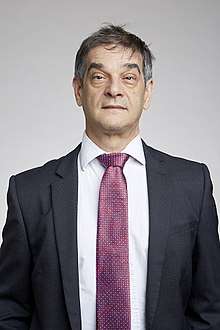Lawrence Paulson
Lawrence Charles Paulson FRS[2] (born 1955)[1] is an American computer scientist. He is a Professor of Computational Logic at the University of Cambridge Computer Laboratory and a Fellow of Clare College, Cambridge.[5][6][7][8][9]
Lawrence Paulson | |
|---|---|
 Lawrence Paulson at the Royal Society admissions day in London, July 2017 | |
| Born | Lawrence Charles Paulson 1955 (age 64–65)[1] |
| Citizenship | US/UK |
| Alma mater | |
| Known for | |
| Spouse(s) |
|
| Awards |
|
| Scientific career | |
| Fields | |
| Institutions | University of Cambridge Technical University of Munich |
| Thesis | A Compiler Generator for Semantic Grammars (1981) |
| Doctoral advisor | John L. Hennessy[6] |
| Website | www |
Education
Paulson graduated from the California Institute of Technology in 1977,[10] and obtained his PhD in Computer Science from Stanford University in 1981 for research on programming languages and compiler-compilers supervised by John L. Hennessy.[6][11]
Research
Paulson came to the University of Cambridge in 1983 and became a Fellow of Clare College, Cambridge in 1987. He is best known for the cornerstone text on the programming language ML, ML for the Working Programmer.[12][13] His research is based around the interactive theorem prover Isabelle, which he introduced in 1986.[14] He has worked on the verification of cryptographic protocols using inductive definitions,[15] and he has also formalised the constructible universe of Kurt Gödel. Recently he has built a new theorem prover, MetiTarski,[3] for real-valued special functions.[16]
Paulson teaches an undergraduate lecture course in the Computer Science Tripos, entitled Logic and Proof[17] which covers automated theorem proving and related methods. (He used to teach Foundations of Computer Science[18] which introduces functional programming, but this course was taken over by Alan Mycroft and Amanda Prorok in 2017[19], and then Anil Madhavapeddy and Amanda Prorok in 2019[20]. )
Awards and honours
Paulson was elected a Fellow of the Royal Society (FRS) in 2017,[2] a Fellow of the Association for Computing Machinery in 2008[4] and a Distinguished Affiliated Professor for Logic in Informatics at the Technical University of Munich.[21]
Personal life
Paulson has two children by his first wife, Dr Susan Mary Paulson, who died in 2010.[22] Since 2012, he has been married to Dr Elena Tchougounova.[1]
References
- Anon (2017). "Paulson, Prof. Lawrence Charles". Who's Who. ukwhoswho.com (online Oxford University Press ed.). A & C Black, an imprint of Bloomsbury Publishing plc. doi:10.1093/ww/9780199540884.013.289302. (subscription or UK public library membership required) (subscription required)
- Anon (2017). "Professor Lawrence Paulson FRS". royalsociety.org. London: Royal Society. Retrieved 5 May 2017.
- Akbarpour, B.; Paulson, L. C. (2009). "Meti Tarski: An Automatic Theorem Prover for Real-Valued Special Functions". Journal of Automated Reasoning. 44 (3): 175. CiteSeerX 10.1.1.157.3300. doi:10.1007/s10817-009-9149-2.
- Anon (2008). "Professor Lawrence C. Paulson". awards.acm.org. Association for Computing Machinery. Retrieved 12 April 2016.
- Lawrence Paulson publications indexed by Google Scholar

- Lawrence Paulson at the Mathematics Genealogy Project
- Lawrence Paulson author profile page at the ACM Digital Library
- Lawrence C. Paulson at DBLP Bibliography Server

- Lawrence Paulson publications indexed by the Scopus bibliographic database. (subscription required)
- Lawrence Paulson ORCID 0000-0003-0288-4279
- Paulson, Lawrence Charles (1981). A Compiler Generator for Semantic Grammars (PDF). cl.cam.ac.uk (PhD thesis). Stanford University. OCLC 757240716.
- Paulson, Lawrence (1996). ML for the working programmer. Cambridge New York: Cambridge University Press. ISBN 978-0521565431.
- "ML for the Working Programmer". University of Cambridge. Retrieved 25 November 2015.
- Paulson, L. C. (1986). "Natural deduction as higher-order resolution". The Journal of Logic Programming. 3 (3): 237–258. arXiv:cs/9301104. doi:10.1016/0743-1066(86)90015-4.
- Paulson, Lawrence C. (1998). "The inductive approach to verifying cryptographic protocols". Journal of Computer Security. 6 (1–2): 85–128. CiteSeerX 10.1.1.57.2049. doi:10.3233/JCS-1998-61-205. ISSN 1875-8924.
- Paulson, L. C. (2012). "Meti Tarski: Past and Future". Interactive Theorem Proving. Lecture Notes in Computer Science. 7406. pp. 1–10. CiteSeerX 10.1.1.259.5577. doi:10.1007/978-3-642-32347-8_1. ISBN 978-3-642-32346-1.
- Paulson, Larry. "Logic and Proof". University of Cambridge. Retrieved 27 January 2020.
- Paulson, Larry. "Foundations of Computer Science". Retrieved 25 November 2015.
- "Department of Computer Science and Technology – Course pages 2017–18: Foundations of Computer Science". www.cl.cam.ac.uk. Retrieved 27 January 2020.
- "Department of Computer Science and Technology – Course pages 2019–20: Foundations of Computer Science". www.cl.cam.ac.uk. Retrieved 27 January 2020.
- "Certificate of Appointment" (PDF). TU Munich. Retrieved 12 April 2016.
- Paulson, Laurence (2010). "Susan Paulson, PhD (1959–2010)". University of Cambridge. Retrieved 25 November 2015.